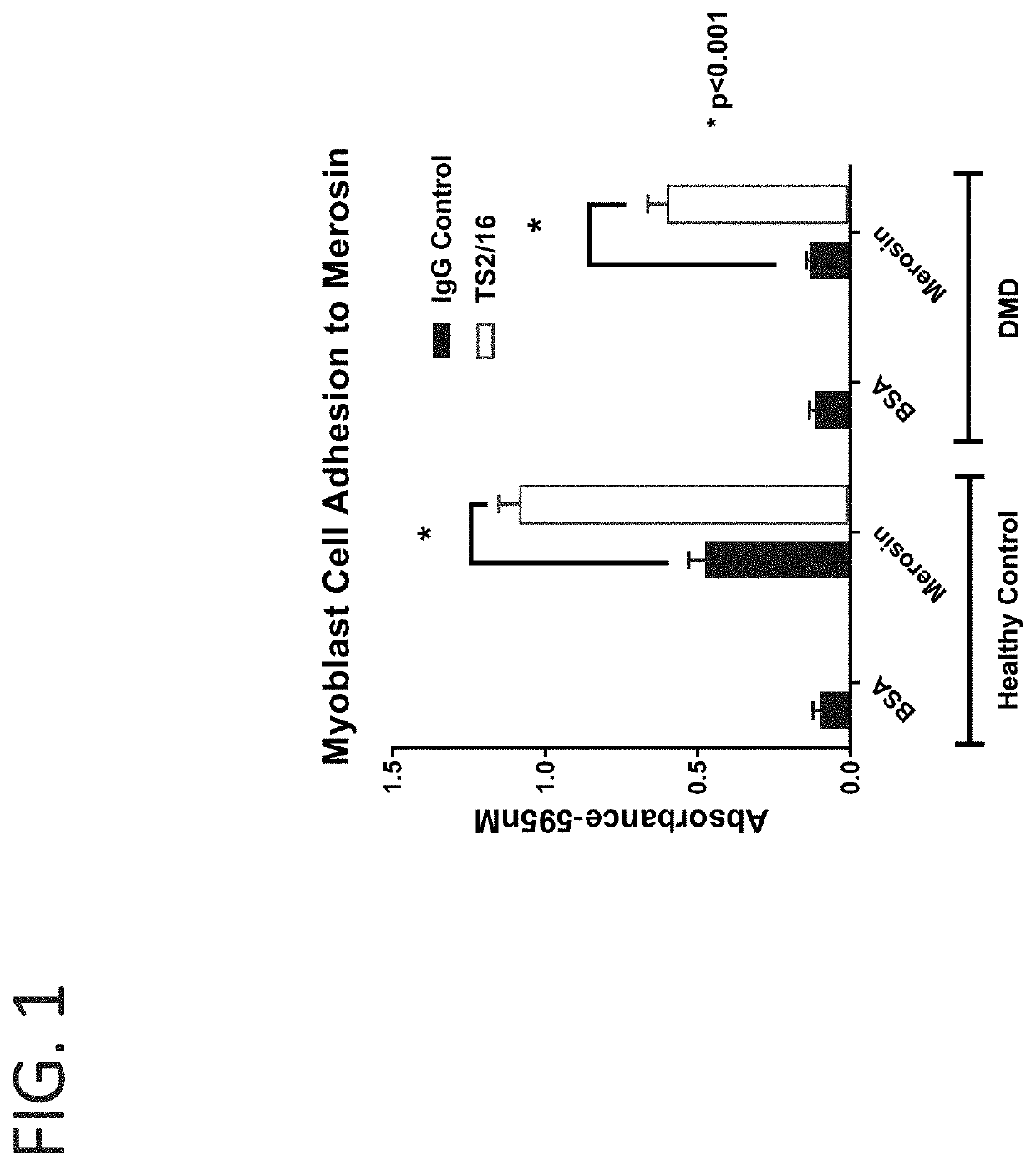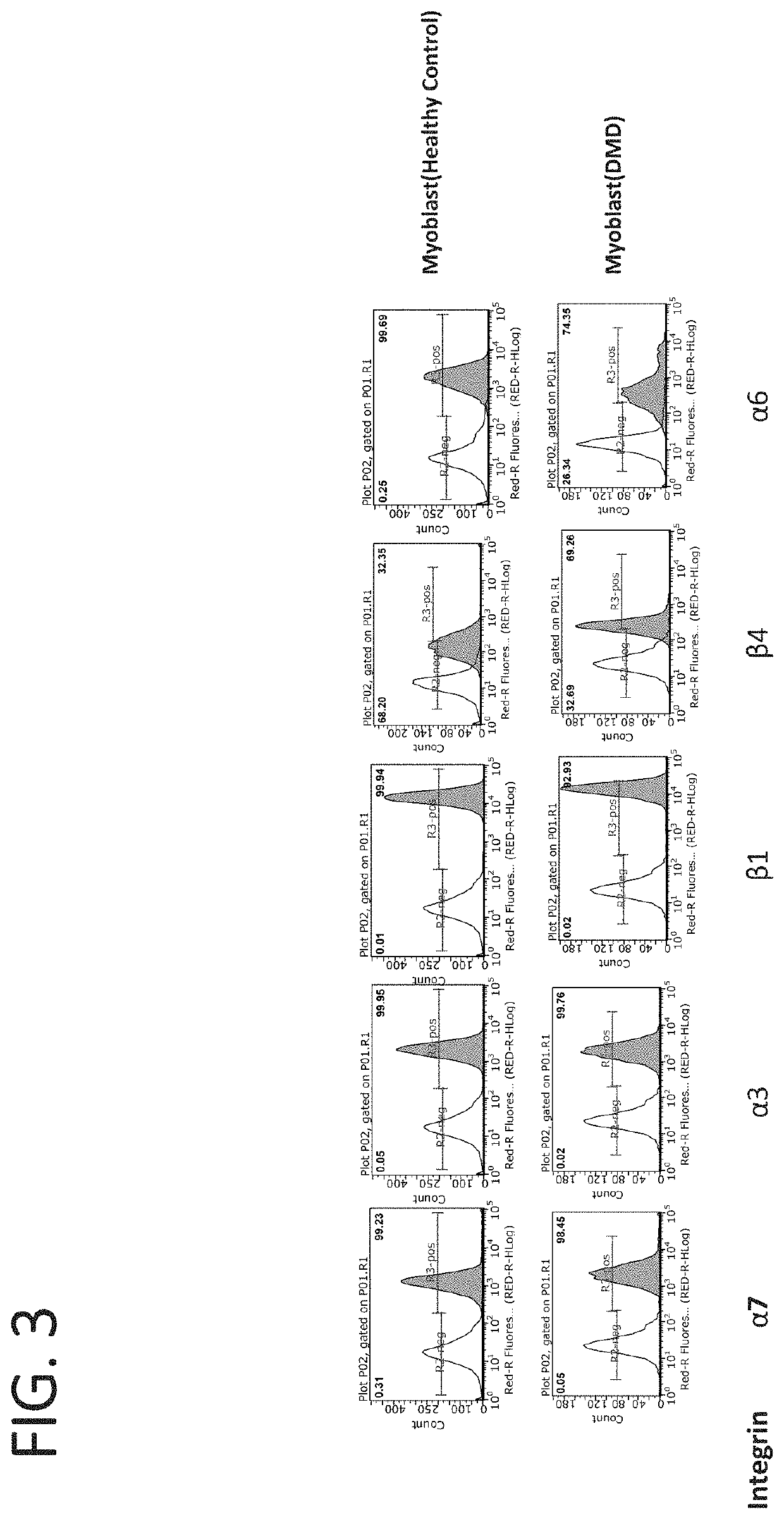Compositions and methods for activation of integrins
a technology of integrin and heterodimer, which is applied in the field of compositions and methods for activating integrin heterodimer, can solve the problems of delayed development, impaired mobility, and no current cure for any form of muscular dystrophy, and achieve the effects of reducing muscle injury, reducing eccentric muscle injury, and reducing muscle injury
- Summary
- Abstract
- Description
- Claims
- Application Information
AI Technical Summary
Benefits of technology
Problems solved by technology
Method used
Image
Examples
example 1
n Agonist Provides Compensatory Effects in Cells with a Dystrophin Deficiency
[0210]Myoblasts and myotubes from healthy and dystrophin deficient human patients were treated with the β1 agonist antibody TS2 / 16 (J. Immunol, 1984, 132:3011). Cell adhesion assays were used to evaluate the cell attachment to laminin through integrins. Microplates were coated overnight with 10 μg / ml merosin at 4° C., and blocked with 2% BSA / PBS for 30 min before the assay. Myoblast or myotube cells were detached and washed in PBS. After that, the cells were resuspended in IMEM at 1.0×106 cells / ml, and fifty microliters of cell suspension and fifty microliters of antibody solution were added into the plate. The plates were incubated for one hour at 37° C. in humidified 5% carbon dioxide. Non-adherent cells were removed by centrifugation top side down at 58 g for 5 min. The attached cells were fixed and stained with 0.5% crystal violet (in 20% methanol and 1% formaldehyde) and the wells washed with PBS. Crys...
example 2
n of α7B1 Agonist Antibodies
[0213]Monoclonal antibodies were generated by immunizing mice with human integrin α7β1 protein ectodomain. A general schematic of the process is shown in FIG. 9. Hybridomas were produced by standard techniques. From a total of 9,000 clones, 110 clones were selected as integrin α7β1 binders. Multiple antagonist (blocking) and four agonist (activating) antibodies were identified in functional biochemistry and cellular assays. These antibodies were characterized as either activating or blocking in a solid phase binding assay and a cell adhesion assay. The activating antibodies are referred to as M10, M25, M36 and M38. FIG. 10A shows an example of results from a solid phase binding assay, and FIG. 10B shows an example of results from a cell adhesion assay performed with two activating antibodies (M10, M25) and one blocking antibody (M20). The activating antibodies were further characterized (for example, by ELISA or flow cytometry) to determine whether the ac...
example 3
n and Characterization of Humanized α7β1 Agonist Antibodies
[0219]The sequence of the M36 / M38 antibody was subsequently humanized. The antibody sequence was analyzed for three dimensional structure and was built by homology modeling. Key positions supporting the CDR loop structure and VH-VL interface were identified. Multiple humanized variants were designed for both heavy and light chains. The humanness of humanized variants were assessed by the T20 humanness score described in Gao et al., (2013) BMC Biotechnology, 13:55. The humanized antibodies as well as a chimeric version (rodent variable regions, human constant regions) were expressed at the 10 mL scale in CHO cells (TunaCHO™ Process) and purified. Binding affinity of each antibody produced was tested by flow cytometry and ELISA.
[0220]A humanized antibody referred to as “VL3VHK20TFT” was isolated. The amino acid and nucleotide sequences of various regions of VL3VHK20TFT are provided in Table 3. VL3VHK20TFT belongs to the IgG4 i...
PUM
| Property | Measurement | Unit |
|---|---|---|
| threshold | aaaaa | aaaaa |
| threshold | aaaaa | aaaaa |
| frequency | aaaaa | aaaaa |
Abstract
Description
Claims
Application Information
 Login to View More
Login to View More - R&D
- Intellectual Property
- Life Sciences
- Materials
- Tech Scout
- Unparalleled Data Quality
- Higher Quality Content
- 60% Fewer Hallucinations
Browse by: Latest US Patents, China's latest patents, Technical Efficacy Thesaurus, Application Domain, Technology Topic, Popular Technical Reports.
© 2025 PatSnap. All rights reserved.Legal|Privacy policy|Modern Slavery Act Transparency Statement|Sitemap|About US| Contact US: help@patsnap.com



